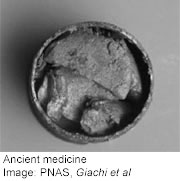
TUESDAY, Jan. 8 (HealthDay News) — Archeologists investigating an ancient shipwreck off the coast of Tuscany report they have stumbled upon a rare find: a tightly closed tin container with well-preserved medicine dating back to about 140-130 B.C.
A multi-disciplinary team analyzed fragments of the green-gray tablets to decipher their chemical, mineralogical and botanical composition. The results offer a peek into the complexity and sophistication of ancient therapeutics.
“The research highlights the continuity from then until now in the use of some substances for the treatment of human diseases,” said archeologist and lead researcher Gianna Giachi, a chemist at the Archeological Heritage of Tuscany, in Florence, Italy. “The research also shows the care that was taken in choosing complex mixtures of products — olive oil, pine resin, starch — in order to get the desired therapeutic effect and to help in the preparation and application of medicine.”
The medicines and other materials were found together in a tight space and are thought to have been originally packed in a chest that seems to have belonged to a physician, said Alain Touwaide, scientific director of the Institute for the Preservation of Medical Traditions, in Washington, D.C. Touwaide is a member of the multi-disciplinary team that analyzed the materials.
The tablets contained an iron oxide, as well as starch, beeswax, pine resin and a mixture of plant-and-animal-derived lipids, or fats. Touwaide said botanists on the research team discovered that the tablets also contained carrot, radish, parsley, celery, wild onion and cabbage — simple plants that would be found in a garden.
Giachi said that the composition and shape of the tablets suggest they may have been used to treat the eyes, perhaps as an eyewash. But Touwaide, who compared findings from the analysis to what has been understood from ancient texts about medicine, said the metallic component found in the tablets was evidently used not just for eyewashes but also to treat wounds.
The discovery, Touwaide said, is evidence of the effectiveness of some natural medicines that have been used for literally thousands of years. “This information potentially represents essentially several centuries of clinical trials,” he explained. “If natural medicine is used for centuries and centuries, it’s not because it doesn’t work.”
A report on the analysis of the tablets was published in this week’s issue of the Proceedings of the National Academy of Sciences.
The shipwrecked boat — the Relitto del Pozzino — was found in the Gulf of Baratti in 1974 and first explored eight years later. The analysis of the tablets was begun about two years ago, Giachi said. The vessel, about 50 to 60 feet long, was found in an area considered a key east-west trade route.
In addition to the pills, archeologists found other remnants of early medicine: a copper bleeding cup, a tin pitcher, 136 boxwood vials, and tin containers.
The tablets were well preserved for the last 2,000 years because the cylindrical tin container in which they were stored, called a pyxis, was hermetically sealed by the natural degradation of the metal, Giachi said, adding that very few other ancient medicines have been discovered elsewhere.
“In London, a granular cream was discovered in a small tin canister. It was dated to the second century A.D. and was probably used as moistening or medicinal cream,” Giachi said.
Giachi noted that another botanical medicine was found at the bottom of a dolium — a large Roman earthenware container — from the first century A.D., recovered near Pompeii. Also, in Lyon, France, cylindrical rods recovered from a second century A.D. burial site were considered to be eyewashes.
To analyze the material found in the shipwreck, a fragment from the original tablets was studied with light microscopy and a scanning electron microscope, Giachi explained. DNA sequencing was used to analyze the organic elements.
Other experts in the field lauded the discovery as a rare find that offered valuable clues to the actual types of materials used in ancient medicine.
“What we know about ancient medicine is largely contained in manuscripts, often corrupt — copied and recopied and fragmentary,” said Michael Sappol, an historian in the history of medicine division of the U.S. National Library of Medicine. “When the manuscripts refer to plants, it’s not always evident what they’re referring to. There’s a lot we don’t know.”
Dr. Mark Fromer, an ophthalmologist at Lenox Hill Hospital in New York City, said it makes sense that the medicine that was discovered on the ship was an eye wash to treat dry eye, a common condition even today. “It’s easy to make: it’s saline, which has a pH [acid balance] close to tears,” he explained. “It’s fascinating to realize that the problems that faced men and women thousands of years ago haven’t changed.”
More information
Learn more about the history of medicine from the U.S. National Museum of Health and Medicine.

